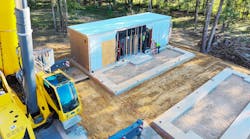Sustainability in the Age of AI Hypergrowth
As the data center industry rapidly expands to support new AI capability, so too do the sustainability challenges—and opportunities we face. Increasingly, sustainability is no longer viewed in isolation but as part of a broader matrix of business imperatives. The era of hypergrowth has elevated the importance of speed-to-market, cost savings, resilience, and power availability. The sustainability innovations our industry must now prioritize will not only advance environmental goals but also enhance performance across these critical factors simultaneously. Thankfully, this convergence has been underway for some time. With the right kind of collaboration among solution providers, data center operators, utilities, and even local communities, we need not trade off one business value for another.
Renewable Energy
Solar, wind, and storage are now the most cost-effective new sources of energy that can be added to the grid in nearly every global market. In 2024, over 92% of new power capacity came from renewables, and in the United States, 96% of new additions to the grid were emissions free. Even in a state like Texas—despite lacking a renewable energy mandate--renewables have outpaced fossil fuels, accounting for the vast majority of new additions over the past two years.
Importantly, renewables are not just the cheapest, but among the fastest to deploy. Grid-scale solar and storage projects can be completed in 12-18 months, compared to four or more years for a combined-cycle gas plant. Recently, the wait times for gas generators has stretched past five years, and despite the announcements of new manufacturing capacity, industry experts don’t expect these backlogs to be significantly reduced.
Renewable energy is no longer just a sustainability investment, but vital to our industry getting the power we need to build. Data center developers are leveraging its affordability and speed to market in many ways, including renewable PPAs and behind-the-meter fuel cells, storage, and solar. These resources can serve as a bridge to utility power, permanent prime power, or as a replacement for diesel backup to support occasional grid interaction and optimization of cost and carbon. Onsite power systems also enhance data center resilience against energy system disruptions.
Efficiency
As energy prices rise, operational efficiency improvements can offer both emissions reductions and substantial cost savings. Between 2007 and 2020, the industry saw dramatic improvements in PUE, keeping the overall load of global data centers flat despite rapid growth. For the past decade or so, the conventional wisdom has been that all the low-hanging fruit on the efficiency tree has been picked, and PUE has remained relatively steady. Now, as we redesign data centers for AI workloads, with unprecedented rack densities and new cooling architectures, new opportunities for cost savings are emerging.
Schneider Electric recently published a white paper on this topic, Bending the Energy Curve: Decoupling Digitalization Trends from Data Center Energy Growth. The paper makes a data-driven case that there are many untapped opportunities for improved data center efficiency, and that these improvements can yield a significant “bending” of the overall load growth curve of our industry out to 2030.
Data center operators need to look at every system of the facilities they are designing to ensure that these efficiency opportunities are seized, from high efficiency power, cooling and IT equipment, to integrated monitoring and controls for power, building, and IT infrastructure.
Embodied Carbon
As suppliers to the data center industry, we at Schneider have seen a significant uptick in the number and rigor of embodied carbon requests and requirements coming from our customers in 2025. As the pace of data center construction accelerates, so does the associated environmental impact, and upstream Scope 3 emissions have become the most challenging element of many data center company’s sustainability plans.
However, hypergrowth is not just a challenge, but an opportunity. The enormous purchasing power of our industry means that we can move markets to be more cost effective, quick, and sustainable. Hyperscalers are already helping to foster the green steel industry, with new deals announced in the last couple months from Microsoft with Stegra and Meta with Electra. Data centers are also seeking improved circularity in their supply chains. Better reuse of equipment and materials could establish shorter supply chains that are not just more sustainable, but more cost effective.
Collaboration is Key
Public awareness of data centers is on the rise, and our prospective neighbors have been organizing to oppose data center development, resulting in canceled projects. With rising energy costs in the United States, this trend may intensify. As an industry, we must demonstrate to the communities in which we build that we can do so in a way that mitigates rising energy costs, air pollution, and other environmental impacts. This will take collaboration not just with community members, but within the data center ecosystem. Cooperation is essential to realizing sustainability alongside cost control, resilience, speed to market and community acceptance. From the materials used in the construction of a data center, to the CIT and MEP equipment inside, and the power that runs it all, suppliers, data center developers, and end users must come together to innovate, and build a data center industry that is truly sustainable, in every sense of the word.
About the Author

Alex Rakow
Alex Rakow is Sustainability Director for Secure Power and Data Centers at Schneider Electric, where he works with data center operators and partners to advance their sustainability and energy performance through partnership on supply chain decarbonization, power strategy, efficiency, and many other topics.
Schneider Electric is a global energy technology partner bringing world-leading expertise in electrification, automation and digitization to smart industries, resilient infrastructure, future-proof data centers, intelligent buildings, and intuitive homes. Anchored by our deep domain expertise, we provide integrated end-to-end lifecycle AI enabled Industrial IoT solutions with connected products, automation, software and services, delivering digital twins to enable profitable growth for our customers.



